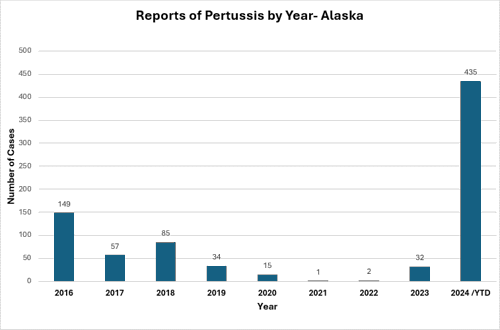Pertussis
Whooping sound cough that makes it hard to breathe
Overview
Pertussis, also known as whooping cough, is a highly contagious respiratory disease. It is caused by the bacterium Bordetella pertussis. It is spread through the air in droplets produced during coughing or sneezing.
Symptoms & Diagnosis
Pertussis, widely known as, "whooping cough," is known for uncontrollable, violent coughing which often makes it hard to breathe. After fits of many coughs, someone with pertussis often needs to take deep breaths which result in a "whooping" sound.
Symptoms usually show up 5 to 10 days after being exposed to the bacteria, but it can take up to 3 weeks. In the beginning, it looks like a common cold with symptoms such as a runny or stuffy nose, a low-grade fever, and a mild cough. One to two weeks after the first symptoms of whooping cough, people may start having coughing fits, feel very tired afterward, and have trouble sleeping. These fits can last up to 10 weeks, and the coughing usually becomes worse as the illness goes on.
Pertussis can affect people of all ages, but it can be very serious, even deadly, for babies less than a year old.
Treatment
Whooping cough can be treated with antibiotics like azithromycin, especially when started early, to reduce severity and prevent spreading the infection. Staying hydrated and resting, is also important, and hospitalization may be needed in severe cases, particularly for infants or people with breathing difficulties.
Prevention
The best way to protect against pertussis is by getting vaccinated. The DTaP vaccine is for young children and the Tdap vaccine for older children and adults.
Reporting
Health care providers and laboratories are required to report pertussis within two working days.
Learn more about reportable conditionsResources
Pertussis Data in Alaska
Pertussis Data in Alaska
Pertussis Fact Sheet
Alaska Surveillance Data (last updated 10/21/2024)
*Counts are provisional and may be updated.
*Includes confirmed and probable cases.


Alaska Surveillance Data (last updated 10/21/2024)
*Counts are provisional and may be updated.
*Includes confirmed and probable cases.
CDC reports pertussis cases were lower than usual over the past few years, during and following the COVID-19 pandemic. However, the United States is beginning to return to pre-pandemic patterns. Pertussis is cyclic in nature, with peaks in disease every 3 to 5 years. As typical infection patterns return to the United States, CDC expects pertussis cases to increase both in unvaccinated and vaccinated populations. Pertussis occurs in vaccinated people since protection from vaccination fades over time.
Vaccine Recommendations
Vaccine Recommendations
-
All children and adults should be up to date on recommended pertussis vaccines. See CDC’s recommended vaccine schedule
-
Prioritize vaccinating people who come into direct contact with infants under 1 year old.
-
Pregnant women at 27–36 weeks gestation (third trimester) should receive 1 dose of Tdap vaccine (during each pregnancy).
Resources for the General Public
Resources for the General Public
-
About Pertussis from the CDC. This website site offers extensive, updated information on pertussis for everyone, from kids to health care providers. Check it out now!
-
Pertussis Fact Sheet from the Alaska Division of Public Health
-
Pertussis FAQs from the Alaska Division of Public Health
-
Information for patients with pertussis from the Alaska Division of Public Health
-
Pertussis Flyer from the Alaska Division of Public Health
Resources for Healthcare Providers
Resources for Healthcare Providers
-
Pertussis Disease Information for Clinicians from the CDC. Website has disease specifics, treatment, clinical features, clinical complications, diagnostic testing, prevention, and provider education information.
-
Testing: Collect a nasopharyngeal swab for pertussis PCR (recommended method)
-
See CDC’s best practices for using PCR to diagnose pertussis.
-
Treat: following CDC’s treatment guidance.
-
Instruct: people with suspected pertussis to stay home from work, school, or childcare. Advise them that they are considered contagious until they complete 5 full days of prescribed antibiotics.
-
Consider: Preventive antibiotics for the entire household if a member meets any high-risk criteria. PEP Use
- Testing Menu: Bordetella Pertussis
Public Health Alerts
Public Health Alerts
Alaska Public Health Alert Network (PHAN):AKPHAN: Increase in Pertussis Activity in Alaska (August 5, 2024)
Interim Guidance: Fall 2024
Interim Guidance: Fall 2024
Interim Alaska pertussis recommendations -Updated 9/24/2024